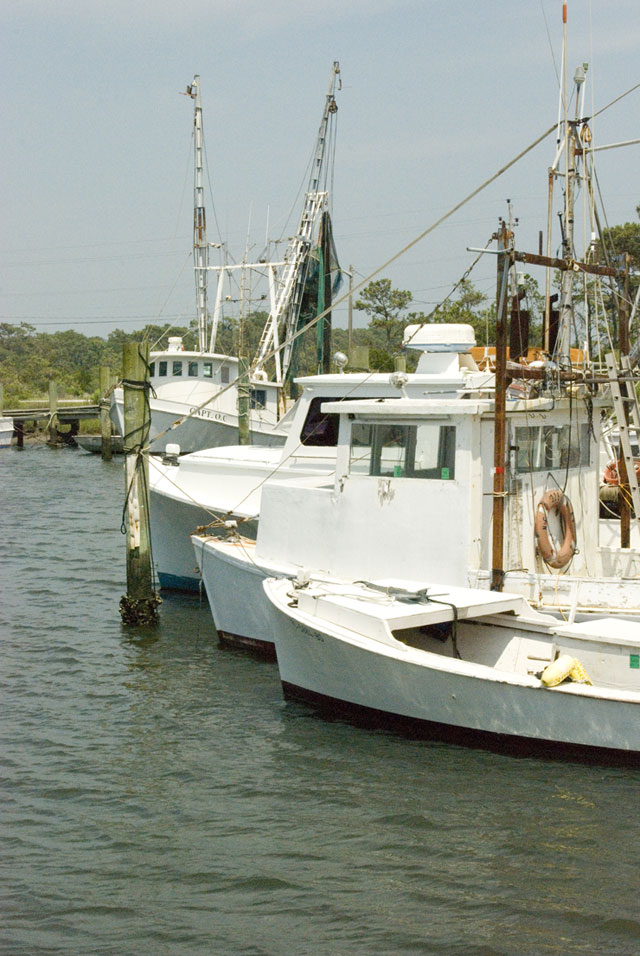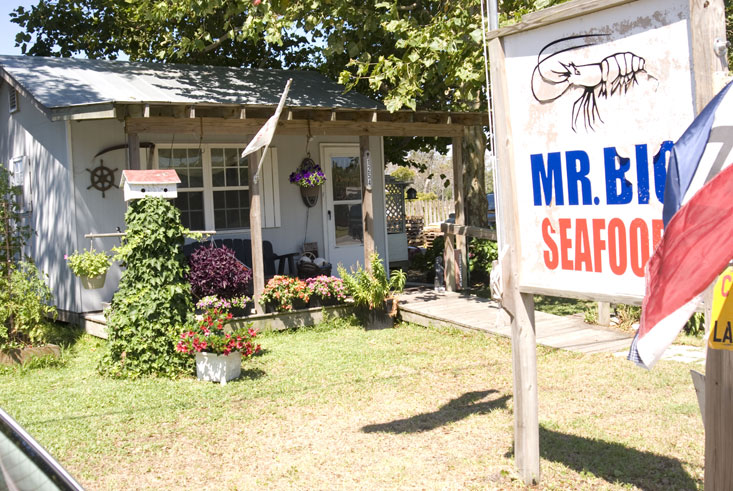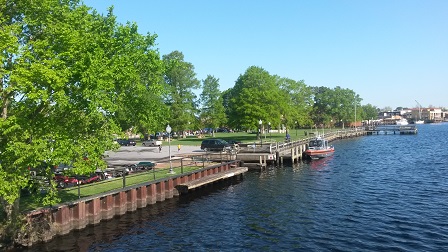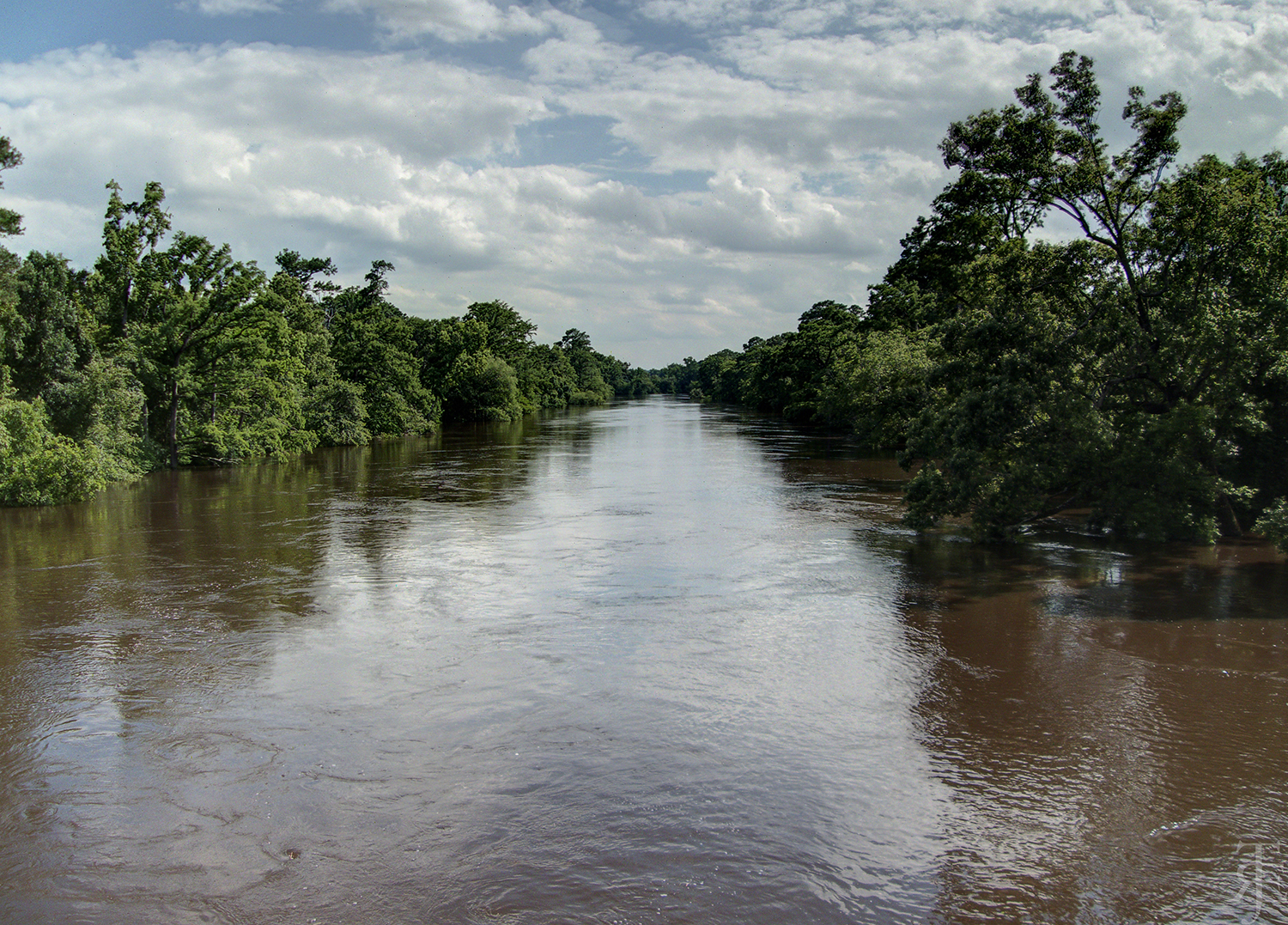A Sense of Place: Down East and Beyond

Lillie Chadwick Miller rattles off various services her family has provided in a shop on Harkers Island. Since 1941, it has been a grocery, a filling station, an outboard motor repair business and a bait-and-tackle shop.
Now, her sons — Christopher, 22, and Mike, 26 — are adding kayak rentals and planning tours of nearby coastal birding and paddling trails.
“They want to tap into people coming into the area,” Miller explains. They anticipate a rise in visitors to Carteret County’s Down East region now that the Cape Lookout Lighthouse offers climbing tours each spring through fall.
Like the family business and the region, Miller, too, is changing with the times yet keeping focus on community needs. A retired school principal, she was one of 70 residents and property owners featured in the documentary Voices of Down East, which debuted last year at meetings organized by North Carolina Sea Grant researchers.
Lead researcher Lisa Campbell and producer Gabriel Cumming of Duke University not only presented survey findings and screened the documentary, but also gathered audience feedback.
The film includes natives and newcomers, fishermen and developers, teen to retiree. Miller’s words help to close the film and set the tone for ongoing discussions:
We have got to talk about how to create the communities that we want. We haven’t done that. This may be a good opportunity to start some of those conversations and realize that we have to be part of the plan to make that happen — and it is going to take our time and effort to do that. That is going to have to be the first and biggest step that we are going to take. We are going to have to take responsibility.
What a difference a year makes. The Sea Grant project findings and community efforts have provided leverage for the Core Sound Waterfowl Museum and Heritage Center, led by Karen Amspacher, to garner additional funding from the Z. Smith Reynolds Foundation and the North Carolina Rural Center.
Those new projects already have spurred an online newspaper — the Down East Community News, edited by Miller — that offers a virtual gathering spot for residents, friends and visitors, complete with bulletin boards for church fundraisers, storytellers spinning their yarns and topical forums.
Other projects include one to identify and map community treasures and assets. “Seeing and hearing what we do have here — the people, history, culture and assets — will bring a pride in ourselves,” Miller says.
That renewed pride signals a shift away from pervasive negativity she had sensed in recent years from residents in Down East communities — from the North River Bridge at Bettie clear to Cedar Island.
Now, she says, folks want to move toward “the possibilities of what we can do.”
SOCIAL SCIENCE
A faculty member at the Duke Marine Laboratory, Campbell did not simply read about and comment on contentious public meetings regarding development in Carteret County in recent years. She saw an opportunity for applied social science, with results that would give communities “information that can help them determine for themselves how to accommodate development while protecting resources critical to local ecosystems, economies and quality of life.”
In 2008, Sea Grant funding allowed Campbell to gather the team to begin the “Change in Coastal Communities: Perspectives from Down East” study to gauge public opinion on the pace of development in the region, trends in land ownership, and attitudes concerning the area’s natural and cultural resources.
Survey results documented community views and attitudes on issues associated with change in the region, such as loss of working waterfronts or increases in stormwater runoff. Better understanding of community views on these issues can help inform policy debates, Campbell says.
The team identified a random sample of 20 percent of the region’s population, including full-time residents, part-time residents and nonresident property owners. The response rate was high: 51 percent of those who received survey questionnaires returned them. “I think that our higher response rate indicates how important these issues are to Down East communities,” Campbell explains, noting that coastal communities in other states face similar challenges.
“Tourism, migration to the coast by year-round or seasonal retirees and people with second homes, and associated development is significantly changing the character, economies, cultures and environments of many coastal communities,” she says. Results show areas of both agreement and disagreement among respondents. For example, almost everyone agrees that Down East has environmental and cultural resources worth protecting, but there is less agreement on how this protection should occur.
More than half of survey respondents say the pace of real estate development in Down East is moving too fast, but most see both positive and negative impacts of the increased development and tourism. Only 18 percent believe increased real estate development will have just negative impacts on the quality of life Down East.
Maintaining environmental quality is identified by 37 percent of survey respondents as the most important issue currently facing Down East communities today, while 25 percent say the top issue is creating new jobs.
The survey results provide statistical data, while the documentary film captures local voices and synthesizes important issues in greater depth.
The research team included graduate student Joshua Stoll, who says the experience is great preparation to be a 2011 Knauss Marine Policy Fellow through the National Sea Grant Office.
In particular, Stoll documented land-use and ownership changes as part of the Sea Grant project, noting changes in parcel size over time. “The past three years have given me perspective on issues that local communities are facing — and the impact that regional and national policy can have on local communities,” he says.
Under Campbell’s leadership, the team focused on rigorous research standards while valuing all participants and comments, thus allowing residents to step back from political and other battles. “Lisa Campbell was critical in getting us to this point,” Amspacher notes. “She gave us evidence of what we knew in our hearts.”
PAST, PRESENT & FUTURE
In the documentary, Amspacher describes her goal:
I would like to see some community-based planning projects. Small projects like fixing up a street corner or fixing up an old building and making it a community center. Some of that is already going on Down East, but to really put that together in an organized effort and a long-term plan and some guidelines and some mechanisms that we can protect ourselves from ourselves. We can be who we are. And we can accommodate those who want to move here, who want to visit here, and still make it a place that local people recognize it as who they are and where they are.
Amspacher and others held tight to that vision and the Sea Grant project’s results as they went looking for funding for the next step. To apply for Rural Center grants, they needed a regional economic project. Hatteras Island in Dare County, Ocracoke Island in Hyde County and Down East Carteret have links that go beyond geography, including a special kinship with the former community on Portsmouth Island.

“They think a lot like us,” Susan West of Hatteras Island says of her regional colleagues and their communities. West is a journalist, blogger and appointee to the N.C. Joint Legislative Commission on Seafood and Aquaculture.
Hatteras is not starting from scratch. West and other partners, including Sea Grant, have been developing the Hatteras Connection program for several years to help the community — especially the youth — retain the island’s identity and promote economic sustainability.
Also, the online Island Free Press, under editor Irene Nolan, has been offering news updates from court battles to basic questions, such as: Is the ferry running today?
To some vacationers, life on Hatteras seems ideal. Yet at times, West says year-round residents often feel “beaten down,” from coping with regulations or tracking the latest weather forecast. “We want folks to open their eyes to the opportunities we have here,” West says. “It is a wonderful place to live. It is a wonderful place to visit.”
Amspacher praises the progress already made on Ocracoke, which has a more compact area. Though fewer in number, the residents there have rallied in recent years to save the island’s last fish house, and have worked through the Ocracoke Foundation on matters such as affordable housing.
And all the communities are benefiting from Mary Helen Goodloe-Murphy’s leadership that resulted in a National Scenic Byway designation that links Hatteras Island by ferry to Ocracoke and on to Cedar Island and Down East.
In addition to the official byway, local loops can tout galleries, fish markets and businesses, as well as landmarks that identify not only tourist spots but also key community elements, such as churches.
Such assets will be cited in the mapping projects.
“The whole project is making us look toward the future,” West explains. “It isn’t easy to have economic development that respects our island, our environmental resources and our cultural resources that are what has made this a special place.”
Recently, Amspacher and Ocracoke’s Alton Ballance went to the to the Island Institute in Maine to share successes and struggles with representatives of other small coastal communities.
Ballance leads the N.C. Center for the Advancement of Teaching’s Ocracoke site, but has worn many hats, including innkeeper, teacher and principal, historian and Hyde County commissioner.
The current Rural Center project includes efforts seeking to retain or create jobs in all three counties. For instance, how can local seafood programs collaborate on marketing and other means to “connect the dots,” yet retain their individual character and flavor?
Working waterfronts, community supported fisheries and heritage tourism are other potential topics. “There is no telling where this could go,” West says.
And planning for the future includes increasing the now limited job opportunities, Amspacher adds.
“We have children who want to move back home.”
Read the complete survey results and watch Voices of Down East by going online to: www.ml.duke.edu/coastalcommunities.
For daily regional news updates, check out: www.downeastcommunitynews.com and www.islandfreepress.com.
Learn more about the communities along the national Outer Banks Scenic Byway: www.byways.org/explore/byways/12834/.
The following quotes were taken from the documentary Voices of Down East.
We have got to talk about how to create the communities that we want. We haven’t done that. This may be a good opportunity to start some of those conversations and realize that we have to be part of the plan to make that happen — and it is going to take our time and effort to do that. That is going to have to be the first and biggest step that we are going to take. We are going to have to take responsibility. — Sarah K. Amspacher
It’s the peace, the tranquility of the ocean. And when you just look around and see what God has given us, it’s just amazing to me. — Elizabeth Ritchey, Retired bank branch manager
I wouldn’t say it’s a wild frontier, but we feel like we’re really away from the rest of the world when we’re down here. — John Moses, Physician
I think living on the water is the greatest thing to me. …You can’t beat waking up in the morning and seeing the sun coming over the water and seeing the birds and animals and stuff like that. Actually it’s perfect to me. — Mitch Mitchum, Family runs a private ferry
The livelihood is driven by the environment — and that could be fishing, crabbing, shrimping, oystering, farming. — John Merriner, Retired from NOAA
Somebody has a heart attack, and is in the hospital — his family is taken care of. I’ve seen it happen. If their house burns down, they’ll hold enough fish fries to buy them a new house trailer as quick as they can, usually within two weeks time. That’s unlike anything I’ve ever seen before I moved here. — Tom Russell, Cabinetmaker
The best compliment I’ve ever had here by a native was one who said to me … that I was really a Harkers Island person. I just had the misfortune of being born somewhere else. — Richard Meissner, Retired teacher/Park Service volunteer coordinator
The fishing, I just love it. When we were little, we were always fishing with, you know, my daddy or uncle or whoever. — Rodney Salter, Commercial fisherman
There was stretches on this island with absolutely no houses…. It was so dark at night, when you were walking along, you couldn’t see your hands before your face. And where the elementary school is now was high woods on both sides and it was so dark. — James Rose, Model boat builder
I can remember the time when I could listen at somebody talk Down East and tell you what community they were from because every community was isolated…. If you wanted to see your girlfriend… It was different when you had to go in a sailboat. — Milton Styron, Retired fisherman
You can roll up to a gas station and you know everybody in there…. If I want a cup of coffee, I know I can go down the street to Davis Shore. You know you walk In and you’re welcomed. — Mike Willard, Pastor
The lifestyle is so much slower there. Nobody gets in a real big hurry. I think these people down there are pretty self-sufficient in one way or another…. They’re the best storytellers. — Donald Jones, Blacksmith
I’ve seen it virtually every place I’ve lived — that there’s a friction. It’s an old saying, “When I move in, I want to shut the door behind me.” And I find that to be true here. Yes, I hate to see people chop down the trees, but I chopped down a few when I built my house, so you know, I guess I have to allow somebody else to do that. — Fred Bisbee, Retired banker/library volunteer
This is a freezer. It’s what it was. We use it for storage now. But that’s how things have changed. We used to keep that full, but you know, we don’t have the product now. We’ve lost a lot of our market share due to imports. There’s a lot of factors, but if you were to ask me the two biggest problems we have, I would tell you… trying to compete in the import market and weather. But I would put three in there: regulations. — Bradley Styron, Commercial fisherman/fish house owner/ marine fisheries commissioner
They never realized that, that piece of land — that their mother and father and grandfather and their ancestors back for hundreds of years had lived on — had a value to it, a money value. When somebody come and offered them a hundred thousand dollars for that land, they couldn’t imagine that much money. And this guy he sold out to ’em… first thing he know there was a fence in front of his old house while they were tearing it down. He had to go around his property to get to his boat. And it wasn’t very much longer he found there’s other people moved in that attaches all up and down the waterfront of Harkers Island, you couldn’t get to the water. By then, the property they had bought across the road, that’s worth a couple hundred thousand dollars, so they sold out and moved to a trailer park on the other side of the bridge. Their plan was to leave it to their children and they can’t afford to do that anymore. — Jenny and Sonny Williamson, Retired writer/storyteller
It’s funny now that we’re turning our subdivision — because of the economy — into a 102-lot RV park, everyone is happy with it. But when it was townhouses in the beginning, when it was then turned into a 35-lot subdivision, they were up in arms. So some of it is they’re afraid of change being the type of people as much as people, which I always thought was kind of unique — and interesting. — Frankie Pendergraph, Developer
I don’t think development in and of itself is bad, but I really object to development that destroys the reason people wanted to be there in the first place. And to me that’s what they’ve done. People were charmed by Harkers Island and they’ve destroyed what was charming about it. By and large for me it’s just the whole experience of Down East is no longer Down East. — Virginia Ritchie, Retired psychotherapist
I don’t know of any other area that you can go and you can see as much wetlands… the marsh… the primary nursery areas that we have in this county. I don’t think that we need to sacrifice that for the sake of affordable housing or development or business or whatever. But I think that we need to find the happy balance in-between where we can have both. — Danielle Taylor, Real estate agent
Down East has traditionally had very much resistance to zoning because there is this independent spirit. We started a little micro-bakery and it was fine. It was unzoned, so we had, it was no problem. It’s nice in cases like that. But in terms of not having any zoning really makes it hard to do any really comprehensive planning. So that’s a barrier, I think. — Stephanie Miscovich, Freelance culinary writer/soil science research consultant
If you want to make decisions that affect you locally and you want local control… town government is the one that does that. The decision would be primarily on planning issues and stuff by your neighbors at least. They may not be agreeing with you, or they may be newcomers — but at least they’ll be neighbors and living in your community. — Jonathan Robinson, County commissioner/ commercial fisherman
This article was published in the Holiday 2010 issue of Coastwatch.
For contact information and reprint requests, visit ncseagrant.ncsu.edu/coastwatch/contact/.
- Categories:


